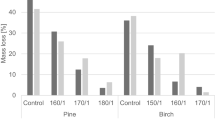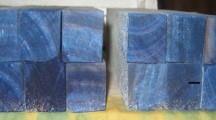Abstract
Laser incised dry (mc=18%) and green (mc=33%) Douglas-fir was treated by the passive impregnation method of wood preservation having two different incising densities (7500 and 10000 holes/m2) and dipping times (3 and 12 hours). A 0.68% active ingredient solution of Copper Azole Type B (Tanalith CY) preservative was used in this study. The preservative retention and penetrated area were measured. The total preservative retention varied from 1.61 to 2.68 kg/m3 depending on the moisture content of wood and conditions of preservation, and in all cases it surpassed the minimum retention requirement for above ground use. The maximum penetrated area for dry lumber (mc=18%) was 96 and 88% across and along the grain, respectively. For green lumber (mc=33%), it was 90 and 85% across and along the grain, respectively.
Zusammenfassung
Laser-perforiertes trockenes (u=18%) und frisches (u=33%) Douglasienholz wurde mittels Tauchimprägnierung nach vorheriger Dampfbehandlung mit zwei unterschiedlichen Lochdichten (7500 und 1000 Löcher/m2) und Eintauchzeiten (3 und 12 Stunden) behandelt. In dieser Studie wurde eine 0.68% Wirksubstanzlösung aus Kupferazol Typ B (Tanalith CY) verwendet. Die Holzschutzmittelaufnahme und der Eindringbereich wurden bestimmt. Die gesamte Holzschutzmittelaufnahme variierte zwischen 1.61 kg/m3 und 2.68 kg/m3 je nach Holzfeuchte und Imprägnierbedingungen. In allen Fällen wurden die Mindestanforderungen für Anwendungen im Außenbereich ohne Erdkontakt übertroffen. Der Imprägnierungsgrad lag bei trockenem Schnittholz (u=18%) bei 96% und 88% bezogen auf die Hirnholz- und die Seitenflächen. Bei frischem Schnittholz (u=33%) lagen diese Werte bei 90 bzw. 85%
Similar content being viewed by others
References
American Wood Preserver’s Association (AWPA) (2003) Annual Book of Standards, Granbury, TX
American Wood Preservers’ Association (AWPA) (1999) Lumber, timber and bridge ties, and mine ties – preservative treatment by pressure processes. Standard C2, AWPA Book of Standards, Granbury, TX
Hattori N, Islam MN, Ando K, Yamauchi H, Kobayashi Y (2007) Penetration of liquid into laser incised lumber by the passive impregnation. The 18th International Wood Machining Seminar, May 7–9, 2007, Vancouver, Canada
Islam MN, Ando K, Yamauchi H, Kobayashi Y, Hattori N (2007a) Comparative study between full cell and passive impregnation method of wood preservation for laser incised Douglas-fir lumber. Wood Sci Technol 42:343–350
Islam MN, Ando K, Yamauchi H, Kobayashi Y, Hattori N (2007b) Penetration analysis of different species and effect of wood moisture content for the passive impregnation of incised sugi lumber. The 57th Annual Meeting of the Japan Wood Research Society, August 8–10, 2007, Hiroshima, Japan
Islam MN, Ando K, Yamauchi H, Kobayashi Y, Hattori N (2007c) Passive impregnation of liquid in impermeable lumber incised by laser. J Wood Sci 53(5):436–441
JIS Z 2101-1994 Methods of test for woods. Japanese Industrial Standard
Krahmer RL (1961) Anatomical features of permeable and refractory Douglas-fir. For Prod J 11(9):439–441
Krahmer RL, Côté WA (1966) Changes in coniferous wood cells associated with heartwood formation. Tappi 46(1):42–49
Kumar S, Morrell JJ (1989) Penetration and absorption of different CCA compositions in six western conifers. For Prod J 39(10):19–24
Lebow ST (1996) Alternatives to chromated copper arsenate for residential construction. Research Paper FPL-RP-618, Madison, WI: US Department of Agriculture, Forest Service, Forest Products Laboratory, 9 p
Miller DJ, Graham RD (1963) Treatability of Douglas-fir from western United States. In: Proceedings of the annual meeting of the American wood preserves association, 1963, USA, 59:218–222
Mitchoff ME, Morrell JJ (1991) Preservative treatment of plywood panels from the Pacific Northwest. For Prod J 41(9):11–18
Author information
Authors and Affiliations
Corresponding author
Rights and permissions
About this article
Cite this article
Islam, M.N., Ando, K., Yamauchi, H. et al. Preservative treatment of Douglas-fir lumber by the passive impregnation method with copper azole . Eur. J. Wood Prod. 67, 77–81 (2009). https://doi.org/10.1007/s00107-008-0291-z
Published:
Issue Date:
DOI: https://doi.org/10.1007/s00107-008-0291-z




